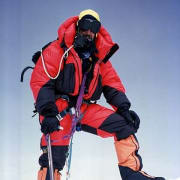Lone Climber Found Dead on Mount Baker

A 39-year old Canadian climber embarked on climbing Mt. Baker in the North Cascades just outside of Bellingham, Washington alone in late September. Tragically, he was found dead Monday, September 30th after failing to check in with his family. The climber was found in a bergschrund. A bergschrund is a deep and often broad crevasse, or series of crevasses, which develop near the head of a mountain glacier.
Alex Didion reported for King 5 News that Whatcom County Sheriff's Office deputies launched a search operation for the 39-year-old man on Sept. 29 at 7:30 a.m. The initial rescue efforts were hampered by inclement weather, difficult terrain and darkness. The Whatcom County Medical Examiner's Office has taken custody of the body and will determine the cause of death. “We mourn with the family and friends of this intrepid climber,” said Sheriff Donnell “Tank” Tanksley in a news release. “It is a heartbreaking outcome, but we are honored to be able to bring him home.” Deputies noted the search effort was made significantly less difficult because the man had a Garmin inReach tracking device with him.
The risk of death will always accompany mountaineers in their adventures into the wilderness and up steep mountains. Such risk increases significantly when climbing on glaciers. Mt. Baker is heavily glaciated and accumulates extreme amounts of snowfall each year. While tragic, the loss of this climber must serve as a harsh lesson to both novice and elite climbers. It is not wise to climb glaciated mountains alone. Typically, climbers rope together in groups of 3-5 to minimize the possibility of perishing after a fall into a crevasse. When roped together, a climber that falls into a crevasse can be stopped by his/ her fellow climbers that arrest the fall with their ice axes. Proper crevasse training further reduces risk of death. This is a heartbreaking loss for the man’s family and friends, one that does not need to be repeated in the same fashion – alone.
Mt. Baker (Koma Kulshan)
Mt. Baker is one of the snowiest places on earth. Mt. Baker is an active stratovolcano part of the Cascade Volcanic Arc, or ‘Pacific Ring of Fire’, a series of volcanoes that includes Mount St. Helens, Mt. Adams, and prominent Mt. Rainier. Mt. Baker, known as Koma Kulshan to the Native American tribes of the Pacific Northwest, rises to an elevation of 10,781 ft. It is the third-highest mountain in the state, and the second most glaciated mountain in the lower-48 states. Only Mt. Rainier boasts more glacier terrain in the US beyond the mountains of Alaska.
While Mt. Baker doesn’t receive the attention of Mt. Rainier, it renowned for its impressive glacial landscapes, featuring ten significant glaciers. The Coleman Glacier on the northwest flank is particularly well-known among climbers and adventurers. The mountain is a popular winter destination for outdoor adventurers, climbers, skiers and snowboarders. The summer months attract hikers, mountain bikers, and mountaineers who seek the challenge of its rugged terrain and spectacular views of Cascade Mountains, Olympic Mountains, Puget Sound and San Juan Islands.
Climbing Mt. Baker
Mt. Baker is required climbing for Pacific Northwest mountaineers. Known for its technical glacial terrain and steep, icy conditions, the climb is challenging and requires proper physical conditions and basic mountaineering skills. Most climbers take the popular Coleman-Deming Route. This route is relatively straightforward for experienced climbers, and a great first-climb for novice mountaineers.
The climb begins at the Heliotrope Ridge Trailhead, located at around 3,700 ft. As climbers progress above the snowfield, they navigate the Coleman Glacier, where they encounter crevasses and icefalls. After crossing the glacier, there is a steep ascent to the saddle between Mount Baker’s two main summits. From there, the final push to the true summit at 10,781 ft. involves negotiating icy sections, and a final steep headwall – the most challenging section on the mountain. Proper gear, including crampons, ice axes, and ropes, are essential for safely engaging any glaciated mountain. (Related Article - Climbing for a Purpose on Mt. Baker)
